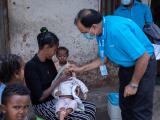Apr 16, 2009 (CIDRAP News) – As polio eradication efforts lost ground in 2008, 15 African countries bore the brunt of the spread of the disease with multiple importations of wild poliovirus, the US Centers for Disease Control and Prevention (CDC) and its global health partners reported today.
Though the disease's spread raises concerns about reaching the global goal of eradication, the CDC also reports some positive developments, such as quicker detection and response patterns that might have limited the size of the outbreaks when compared with a polio resurgence that occurred between 2002 and 2005. The findings appear in today's issue of Morbidity and Mortality Weekly Report (MMWR) and follow on the heels of an Apr 3 CDC report that described last year's 26% spike in polio cases.
The new report describes 32 importations of wild poliovirus (WPV) 1 and 3 into 15 African countries, which led to 96 polio cases from January 2008 to March 2009. The importations have struck three regions of Africa: West Central, the Horn, and South Central. Nigeria was the direct or indirect source of 29 of the importations, which accounted for 68 cases. India was the source for three WPV importations, all of them affecting Angola, which resulted in 28 cases.
In its assessment of polio detection trends in Africa, the CDC reports that the median interval between onset of paralysis in the first identified case to laboratory polio confirmation was 31.5 days, compared with a median of 51 days during the 2002-2005 increase in polio cases.
Response time also decreased, the report says. The median interval from laboratory confirmation to the first large-scale vaccination effort was 27.5 days, compared with 37 days during the 2002-2005 polio resurgence.
Five countries that were previously polio-free experienced WPV importation before 2008 and have seen the virus persist into 2009: Angola, Chad, the Democratic Republic of Congo, Niger, and Sudan. Indicators of routine and supplemental immunization activities suggest lower immunization rates in children in these five countries, compared to the other African countries that had polio reimportation—64% versus 75%. Efforts are under way to strengthen acute flaccid paralysis surveillance and supplemental immunization in these countries, the CDC reports.
The agency says that four countries—Angola, Chad, Nigeria, and Sudan—have been the source of repeated WPV importation into other countries on the African continent since January 2009. The CDC notes that all four countries have weak health infrastructures, low routine vaccine coverage in certain areas, and gaps in supplemental immunization that are due to poor planning and implementation.
Civil war in Angola, Chad, and Sudan in past years may have hurt polio eradication efforts in those countries, the CDC says, adding that Chad and Sudan continue to have civil unrest.
Health officials have not determined the mode of WPV transmission from India to Angola, but the CDC said that studies are underway to identify contributing travel patterns, the report says.
Supplemental immunization activities in affected and neighboring countries will continue in 2009, and the CDC urges all countries that are polio-free to keep their guard up. "Globalized transportation and international migration pose a risk for WPV reintroduction for all countries," the agency states.
CDC. Wild poliovirus type 1 and type 3 importations—15 countries, Africa, 2008-2009. MMWR 2009 Apr 16;58(14):357-62 [Full text]
See also:
Apr 2 CIDRAP News story "Polio eradication efforts lost ground in 2008"


















